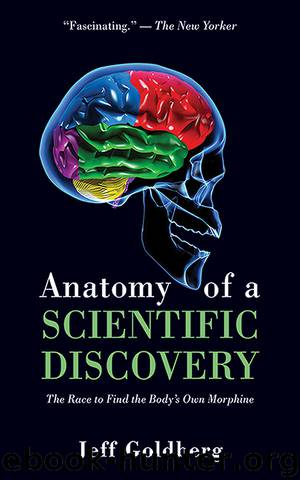Anatomy of a Scientific Discovery by Jeff Goldberg

Author:Jeff Goldberg
Format: epub
Publisher: Skyhorse Publishing (Perseus)
Published: 2012-12-31T16:00:00+00:00
THE ENDORPHIN BUSINESS
The Eli Lilly Pharmaceutical Company complex lacks the sanitized chrome-and-glass architecture that characterizes the drug industry. Lilly’s buildings are hulking, stolid, and made of brick: structures that might just as well house the manufacture of auto parts or dog food. The modern skyline of Indianapolis, Indiana—a city that was built, in part, on Lilly’s success—rises powerfully in the distance behind the Lilly campus and its four sprawling parking lots.
In the basement of the Biological Research building, Robert Frederickson worked in a small room that looked like a lavatory: green linoleum on the floor, tan tiles on the walls, no windows. Fluorescent lights in the ceiling buzzed continuously.
Until recently, Frederickson had shared room S-19 with one of his technicians, a young black woman named Carolyn Harrell, and a bench of twitching, bubbling vas deferens preparations. By the summer of 1977, Carolyn Harrell had moved down the hall and was sharing space with Frederickson’s other technician, Vigo Burgis, in an even smaller room, where Burgis tested and housed rats and mice. For Frederickson, the move meant gaining some much-needed elbow room; for Harrell, it would take some getting used to. Procedures in the animal lab were often bloody, the room smelled, and it was hard for her to eat lunch there. Vigo Burgis’s olfactory senses had long since gone dead.
Frederickson, a slim, slight man, looked even younger than twenty-eight, despite his neatly trimmed beard. He was “a flick-jump specialist,” he liked to say, “a student of rodents,” who had joined Lilly in 1972 after finishing graduate school at the University of Winnipeg in Canada. He had climbed steadily up the company’s research ladder to become chairman of the Central Nervous System committee, the group in charge of overseeing, among other things, all work on opiates. Antibiotics were Lilly’s pharmaceutical mainstay, but narcotics research was an ongoing program in the giant company. Darvon, a mild, orally active pain reliever, was the narcotic division’s most successful product—bringing in nearly $100 million a year in sales.
By 1977, bonus and performance awards put Frederickson’s salary over $50,000, but recently divorced and making alimony payments, he had moved into a tiny apartment in a less-than-luxurious Indianapolis neighborhood. It was not a happy time for him personally, an especially bad time to face another hurdle on his endorphin project.
For nearly three years, Frederickson had been fighting an uphill battle against the skepticism of his superiors to develop an endorphin painkiller at Lilly.
He was among the first drug company scientists to begin such a program because he was one of the first drug company researchers to join the International Narcotics Research Club, having attended the Club’s Chapel Hill meeting in 1973 and the Cocoyoc meeting the following year, where Hans Kosterlitz had made the out-of-the-blue announcement that a morphine-like substance had been discovered in Aberdeen. Returning from Cocoyoc, Frederickson had set up his own vas deferens preparations and had begun to distill human brains from the Indianapolis morgue in search of the as yet unidentified compound.
He was
Download
This site does not store any files on its server. We only index and link to content provided by other sites. Please contact the content providers to delete copyright contents if any and email us, we'll remove relevant links or contents immediately.
Hit Refresh by Satya Nadella(8863)
When Breath Becomes Air by Paul Kalanithi(8043)
The Girl Without a Voice by Casey Watson(7607)
A Court of Wings and Ruin by Sarah J. Maas(7275)
Do No Harm Stories of Life, Death and Brain Surgery by Henry Marsh(6690)
Shoe Dog by Phil Knight(4899)
Hunger by Roxane Gay(4681)
A Higher Loyalty: Truth, Lies, and Leadership by James Comey(4559)
The Rules Do Not Apply by Ariel Levy(4529)
Everything Happens for a Reason by Kate Bowler(4480)
Tuesdays with Morrie by Mitch Albom(4411)
The Immortal Life of Henrietta Lacks by Rebecca Skloot(4262)
How to Change Your Mind by Michael Pollan(4115)
Millionaire: The Philanderer, Gambler, and Duelist Who Invented Modern Finance by Janet Gleeson(4112)
All Creatures Great and Small by James Herriot(3989)
Tokyo Vice: An American Reporter on the Police Beat in Japan by Jake Adelstein(3867)
Elon Musk by Ashlee Vance(3861)
The Money Culture by Michael Lewis(3855)
Man and His Symbols by Carl Gustav Jung(3847)
